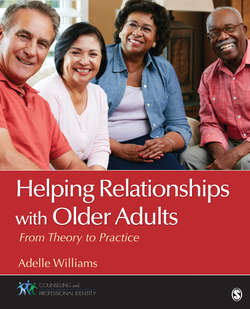Читать книгу Helping Relationships With Older Adults - Adelle M. Williams - Страница 80
На сайте Литреса книга снята с продажи.
Perspective
ОглавлениеMany adults reaching the age of 50 or 60 begin to free themselves from cultural constraints and express themselves in ways that they had not dared before. They become less defined by what others think of them and more by what they think of themselves. Increasingly freed from the burden of always having to fulfill other people’s expectations, their lives start to reflect a new kind of willingness to be exactly who they are. They break free from histories of physical stress, neglect, and abuse. They become more alive (Robbins, 2007). Guided Practice Exercise 3.8 provides the opportunity to explore why and how older persons choose to reinvent themselves in their later years.
Guided Practice Exercise 3.8
Are you familiar with older persons who have decided to “live life to the fullest”? This newfound freedom is not unusual later in life. What activities does he or she now participate in? Examine why this behavior is different from his or her youth. What do you think motivates him or her to break free from past roles, responsibilities, and normative behavior? How do you feel when you hear an older person discussing that he or she just went skydiving at the age of 85?
Scientific studies have found that attitude is profoundly important to health. In 1984, the MacArthur Foundation Research Network on Successful Aging began one of the largest and most interesting aging studies ever undertaken. Recognizing that the field of gerontology had become preoccupied with studies of disability and disease, the Research Network began studying healthy elderly people. A central goal of the MacArthur study was to determine what factors enable some people to retain their mental faculties as they age. The researchers found that one of the most statistically significant predictors of maintaining cognitive functioning with age is the sense of self-efficacy. Elders who have a “can do” attitude are far more likely to retain intact mental abilities (Rowe & Kahn, 1998).
Instead of thinking of it as a tragedy when their bodies begin to slow down, happy older adults accept the limitations that arise and see the transitions they are going through as opportunities to ground themselves in a deeper sense of self and a greater wisdom. Their love for others and the world becomes more accepting. They increasingly let go of minutiae and the nonessentials of life. Their perspective shifts, details soften, and the larger panorama comes into focus. They are able to enjoy life more than when they were young because they have a deeper understanding of it (Robbins, 2007). These are people who do not conform to a youth-obsessed culture’s expectations of what their later years will be like. Instead, their lives come to enact an entirely different vision of aging. No longer so driven by the desires that shaped the first part of their lives, their lives become more about meaning than about ambition, more about intimacy than about achieving. They experience the second half of their life as a time of deepening creativity and ripening of the soul (Robbins, 2007).
